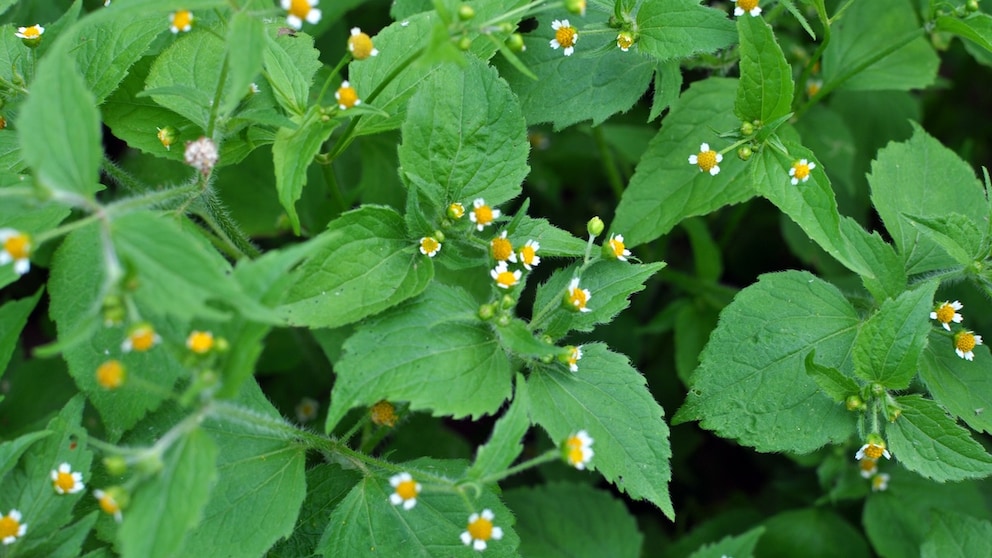March 23, 2025, 2:15 pm | Read time: 5 minutes
As a classic pioneer plant, Frenchweed spreads to any free spot. Read here how you can control the annual weed or make good use of it.
Galinsoga parviflora, commonly known as gallant soldier, quickweed or small-flowered galinsoga, is one of the most prevalent weeds in our gardens. The weed is a classic pioneer plant and prefers to colonize disturbed, exposed soil. It is mainly found in fields but also in vegetable and flower beds. The herb, which belongs to the composite plant family, originally comes from South America, where it was mainly found in potato and maize fields. Today, it is found all over the world. At the end of the 18th century, it was sown in various botanical gardens in Europe and thus began its campaign across the continent — pretty much at the same time as Napoleon. And because people at the time believed that the French troops had introduced the herb, it came to be called French herb.
There are various French herbs. In addition to many species that play no role in this country, there are two common species that are very similar to each other. Small-flowered buttonweed is much more common than shaggy or hairy buttonweed. The following information pertains to the small-flowered galinsoga.
Overview
Appearance and Growth
Gallant soldier is an annual plant that grows to a height of 20 to 40 centimeters, depending on its location. The leaves and stems are only very sparsely and densely hairy. The inflorescences with two to nine flower heads are located at the ends of the branched stems. The yellow flower heads are usually surrounded by five small, white, three-pointed ray florets. There are large gaps between them at the edge of the capitula so that the flowers almost look as if they have been plucked. The flowering period lasts from June until the first frost.
Distinguishing feature: The hairy button plant is much more hairy and also has protruding hairs.
Sowing and Planting Gallant Soldier
If you don’t have any gallant soldier in your garden, you should think carefully about whether you really want to sow it because the herb is extremely prolific. If you want to sow it anyway, the seeds should only be minimally covered with soil, if at all, as the plant requires light to germinate. The optimum germination temperature is 22 degrees, but germination is also possible from around 7 degrees. If you don’t want to sow the fuchsia but want to plant it, you can buy young plants from a few online plant dealers from spring onwards.
Getting Rid of Gallant Soldier
Gallant soldier is removed from the garden far more often than it is sown or planted. If you want to control it, you should remove it before it forms seeds. If it has not yet formed flowers, it can be disposed of in the compost or used as mulch. However, if flowers are already visible, the plant should be disposed of in the organic waste garbage can.
Location and Soil
Small-flowered galinsoga thrives best in sunny to semi-shady locations on fresh to moist, nutrient-rich, well-drained soil that is preferably low in lime.
Varieties
There are no cultivated forms of the small-flowered button plant.
Caring for Gallant Soldier
gallant soldier does not require much care. You know the saying: weeds never die! With its roots reaching up to 80 centimeters deep, it can easily supply itself with water. In normal garden soil, the weed does not need to be fertilized. Cutting it is also not necessary.
Propagation
Gallant soldier propagates by seed, which is produced in large quantities due to the long flowering period. If the weather cooperates, up to three generations can be produced per year. Each plant can produce up to 100,000 seeds, which remain germinable for up to ten years. It is not for nothing that the herb is also known as a garden pest.
Overwintering Gallant Soldier
Gallant soldier does not overwinter, as it is an annual plant that dies with the first frost.
Toxicity
The plant is not only considered non-toxic but even edible. The herb is not only tasty to humans. The herb is also popular with rabbits, guinea pigs, and tortoises.
Alternatives
Chickweed also has the potential to establish itself as a nuisance in the flowerbed due to its tendency to expand. At the same time, it is a nutrient-rich wild vegetable and a great insect plant.
Bee Friendliness
Gallant soldier is a valuable food source for numerous wild bees.
Diseases and Pests
The small-flowered button plant is very robust. It is, therefore, usually spared diseases and pests.
Harvest
Gallant soldier tastes best when it is still young. If it is harvested too late, the lower stems and leaves lose their tenderness. When harvesting, simply pinch off the tips of the shoots. Wrapped in a plastic bag, the cabbage will keep for a few days in the fridge. If you want to keep it for longer, you can also dry it.
Using Gallant Soldier in the Kitchen
In South America, gallant soldier is a prized wild herb that is used like spinach or in soups. It can also enrich salads, egg dishes, sauces, smoothies, or pestos. Its taste is reminiscent of lettuce but tastes a little spicier. The tender leaves, shoot tips, and flowers can be eaten raw, fried briefly, or used as an ingredient in herbal soups and vegetable juices.

Planting and Care Tips How Black Cumin Thrives in the Garden

Planting and Care Tips How Savoy Cabbage Is Grown in the Garden

Delicate summer flowers with bright colors Planting and care tips for cosmos
Use as a Remedy
In its native country, the herb is traditionally used to prepare teas for regeneration after long illnesses. It is very rich in vitamins and minerals, and it is said to purify the blood, lower blood pressure, and promote liver metabolism.

